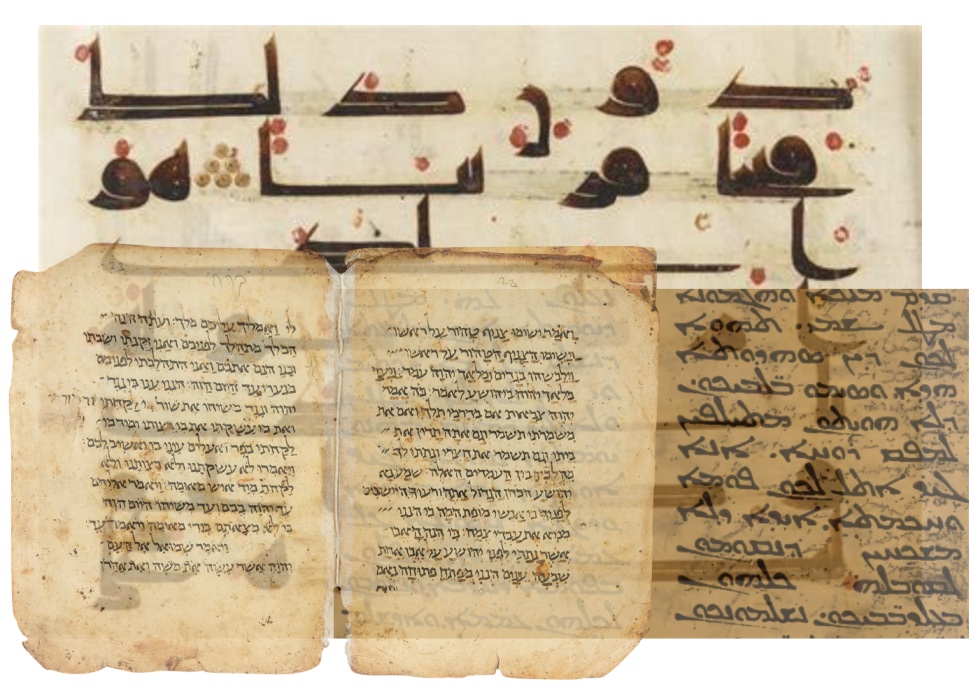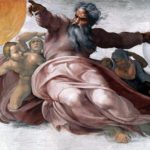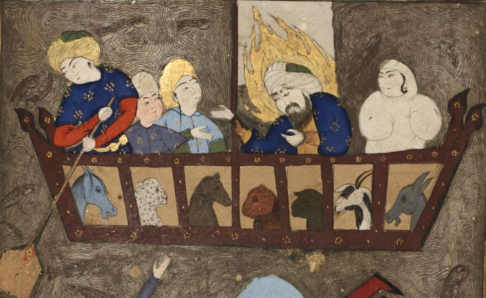
Researchers have been interested in re-reading Qur'anic texts from Gerald Hawting’s point of view[i] (and before him that of Wansbrough[ii]) as a result of the development of Islamic societies, their beliefs and rituals by seeing them, or at least visualizing them, as being compiled from various sources. It is therefore not correct in any way to consider these sources as reflecting a historical reality, since the books of Islamic heritage in this regard are doubtful.
BY NAFI SHABOU
THE QUR’ĀN IS NOT a historical source that we can rely on, it was not written in the Hijaz and it was not written even in the seventh century, as we will show. Taking as an example the work Hagarism by Patricia Crone and Michael Cook,[iii] the methodology they advocate is to deconstruct the understanding of Islam as a traditional epistemological unit, as a result of which they conclude that Islam arose in complete obscurity, with a vague beginning and composed of fragmented traditions that are not concordant with the Islamic understanding of the Qur’ān, the Sunna and the Sīra (biographical works on the Prophet) which for centuries have nevertheless been conjoined with this fragmented heritage.
There is very little material archaeological evidence for Islam that would support this ‘heritage’. The Qur’ān as a text, according to their argumentation, was mostly revealed in Makka, and the people of Makka are supposed to be pagans. But even a cursory acquaintance with the relevant sūras demonstrates that they are speaking of some sort of Jewish-Christian community or a community with Abrahamic traditions and not pagan traditions. Comparative Qur’ānic and New and Old Testament texts can be seen in the Qur’ānic narrative concerning the Israelites, or the stories of prophets such as Joseph and Abraham. The general narrative and its closeness to these compared texts constantly points to a convergence with the texts of the Abrahamic religions.
There is very little material archaeological evidence for Islam that would support this ‘heritage’
This thesis, taken as a whole, sees the Islamic conquests as dating from the era of ‘Abd al-Malik ibn Marwān, and their consequences as the basis for the formation of Islamic culture and its traditions, in that the Arabs became confronted with the required ingredients of civilization. In this assessment, they relied for the origins of Islam on non-Islamic sources from Hebrew, Aramaic, Byzantine Greek and Armenian texts. The intention being to move the study of the text from the documentary arena to the archaeological arena.[iv]
Muḥammad Āl ‘Īsā says in his work The Early History of Islam, part 3:
The idea of multiple authors or compilers of the Qur’ān, or even its translators, is confirmed by the existence of numerous contradictions and objective differences (in the Qur’ānic texts) in addition to the variation in style, which is an indicator of differences in the book. Each writer has his own style, characteristic and spirit that can be felt in the text. [v]
Muslims did not pay attention to their past until some 200 years after the revelation. All these socio-political changes distanced Muslims from the era in which the Qur’ān was revealed (as Muslims claim). The grammarians and commentators were not Arabs from the Hijaz but Persians living in Baghdad, and these did not have an objective idea of the state of society and the ways of the pre-Islamic Arabs, not did they have any knowledge of Semitic languages other than the language of the Qur’ān.
Their interpretation, which is in force to this day, is founded upon their ignorance of the intellectual and social environment in which the Qur’ān was revealed. There are some questions remaining: Did the Arabs of the Hijaz understand the language of the Qur’ān as understood by the Persians of Baghdad, after a period of about 200 years? Ancient Islamic sources that reference the date of the beginning of Islam do not go back further than two centuries while non-Islamic sources give us a different view of what was claimed to be the situation of pre-Islamic Arabs. Some of these sources still exist and have been collected into a volume.[vi]
We do not know the date when the final text of the Qur’ān which we have before us was crystallised. This event may date back to the ninth or tenth century AD, and not to the seventh century as Muslims believe. The Qur’ān, in fact, is nothing but an accumulation of information established gradually over time until it attained to what we are familiar with in our present day.[vii]
The Qur’ān is an accumulation of information established gradually over time
Since the 19th century, researchers have been asking a simple question: Why are the majority of Qur’ānic stories vague and impossible to understand, particularly when they are read for the first time? Why does the Qur’ān not distinguish its stories with names, dates and places? Particularly since it has quoted most of them from the Torah. This would indicate that its readers must have already been familiar with these stories.
Unlike the stories of the Qur’ān, the stories in the Torah and the Bible are very precisely differentiated and feature highly realistic descriptions, since all the elements of the storytelling are included: names of people, places and dates along with a precise narrative structure of introduction / development / conclusion. The Qur’ānic texts appear in historical documents over a period of at least 100 years (approximately between 600-700 AD), and even the phrase muṣḥaf al-Qur’ān (‘the volume of the Qur’ān’) was unknown before the beginning of the ‘Abbasid era.

Suggested Reading
The Bible contains dozens of stories and tales, all detailed in a precise cinematic narrative that enables the reader to easily understand the story, its significance and its lesson. Whereas the Qur’ān is devoid of dates, names or places (with the exception of a few some cases such as Quraysh and ‘Ād).
The stories of the Qur’ān are vague and incomprehensible: Why should this be? The jurists claim that the Qur’ān was a revelation from God that came to complete the revelations of the Gospels and the Torah and to correct what was distorted in them. Yet most of the stories of the Qur’ān are obscure, cut up into parts and scattered here and there over the Qur’ānic text, and have no perceptible literary structure: no introduction, no details, no conclusion (with the except of one sūra the Sūrat Yūsuf). This renders the stories of the Qur’ān obscure and impossible for anyone to understand if they are not referred back to their origin in the Bible.
Indeed Muslim jurists used to refer back to the Torah in order to understand its obscure stories and often poured in copious rivers of Jewish mythology from the Talmud. They authored many works with the title Stories of the Prophets, each of them at various points quoting verbatim from the stories of the Torah and the Talmud, given that there was nothing of this material available in the Qur’ān. The Qur’ān is devoid of history and names of people and places, with the occasional exception such as the names of some Hebrew prophets and some tribes such as Quraysh, Thamūd, and ‘Ād.

Suggested Reading
This is why the faqīh Al-Mas‘ūdī [Baghdad c. 896–956 AD] in his book Meadows of Gold coined a strange technical neologism: Isrā’īliyyāt ‘Israelisms’. Over the history of Islam, jurists used this concept of Isrā’īliyyāt as a tool to marginalize, insult, declare infidel and proscribe the blood of all of their opponents. The student of the Qur’ān will thus inevitably come up against the following facts:
First: the writers of the Qur’ān did not care about or mention the time, place or names of people except in a very few cases;
Second: the writers of the Qur’ān quoted many different sources, especially from the Torah;
Third: the Qur’ān as a work underwent development, and as it developed some elements were added to it and some deleted from it, and at times many parts of it were distorted.
[i] See Gerald Hawting’s work in the Almuslih Library: The Idea of Idolatry and the Emergence of Islam: From Polemic to History .
[ii] See in the Almuslih Library John Wansbrough’s work: Quranic Studies – Sources and Methods of Scriptural Interpretation.
[iii] See the work Hagarism here in the Almuslih Library.
[iv] See this summed up in Ḥamūd Ḥamūd, قراءة نقدية لكتاب هاوتينغ “فكرة الوثنية ونشوء الإسلام
[v] See M. A. ‘Īsā, تاريخ الاسلام المبكر in the Almuslih Library.
[vi] For this volume, see Robert G. Hoyland, Seeing Islam As Others Saw It. A Survey and Evaluation of Christian, Jewish and Zoroastrian Writing On Early Islam, Princeton, The Darwin Press, 1977. The book is available in the Almuslih Library here.
[vii] See Sami Aldeeb, القرآن الكريم بالتسلسل التاريخي للنزول وفقا للأزهر in the Almuslih Library. The work includes indications of variant readings, abrogated verses, Judaic and Christian sources, and linguistic problems.
See Part One of this essay here

